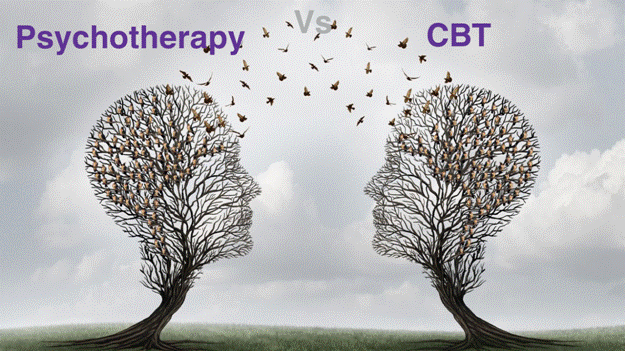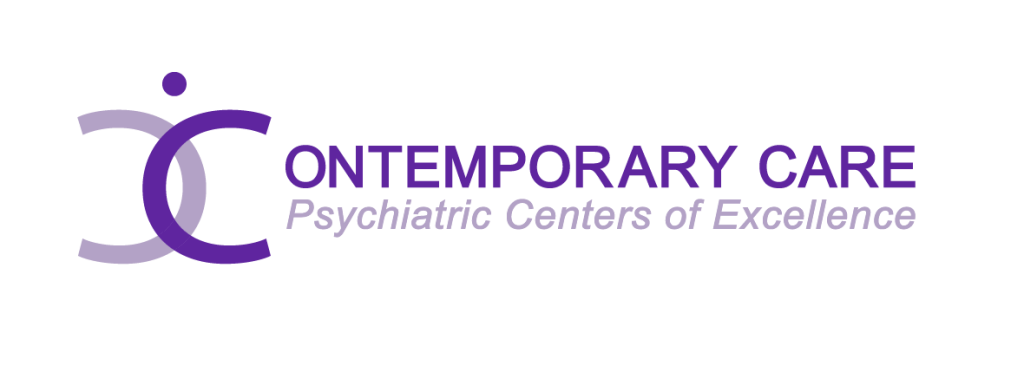Mental health is critical to overall well-being, yet it’s often overlooked or disgraced. However, seeking treatment for mental health disorders is as important as seeking treatment for physical diseases. In the matter of therapy, two commonly discussed approaches are cognitive behavior therapy (CBT) and Psychotherapy. Understanding Psychotherapy vs CBT can help individuals make informed decisions about their mental health journey.
Understanding Cognitive Behavioral Therapy (CBT)
Cognitive Therapy (CBT) is a powerful form of psychotherapy that aims at the complex interaction between our thoughts, emotions, and actions.
Types of Cognitive Behavioral Therapy
Cognitive Behavioral Therapy (CBT) includes various approaches that share the core principles of identifying and modifying negative thought patterns and behaviors. Here are some of the most common types of CBT:
Traditional Cognitive Behavioral Therapy vs Psychotherapy
Overview: Traditional cognitive behavioral therapies, such as ERP (Exposure and Response Prevention) focus on identifying and challenging negative thought patterns that contribute to emotional distress and maladaptive behaviors.
Key Principles: Therapists work with clients to recognize cognitive changes, such as anxiety Depression Panic disorder PTSD Phobias OCD (obsessive compulsive disorder), and develop alternative, more balanced perspectives.
Techniques: Techniques may include cognitive restructuring, thought monitoring, and behavioral experiments to test the validity of negative beliefs.
Dialectical Behavior Therapy (DBT)
Overview: DBT combines elements of traditional CBT with mindfulness techniques to help individuals regulate emotions, tolerate distress, and improve interpersonal relationships.
Key Principles: Along with addressing cognitive deformation, DBT emphasizes acceptance and validation of emotions, along with skills training in mindfulness, emotion regulation, interpersonal effectiveness, and distress tolerance.
Techniques: This therapy may include mindfulness meditation, emotion regulation exercises, and interpersonal skills training.
Acceptance and Commitment Therapy (ACT)
Overview: ACT focuses on psychological flexibility by encouraging individuals to accept their thoughts and feelings without judgment and commit to actions aligned with their values.
Key Principles: Therapists help clients identify their core values and develop mindfulness skills to observe and defuse unhelpful thoughts, allowing them to pursue meaningful goals despite discomfort.
Techniques: Techniques may include mindfulness exercises, cognitive defusion techniques, and value clarification exercises.
Rational Emotive Behavior Therapy (REBT)
Overview: REBT, developed by Albert Ellis, focuses on challenging irrational beliefs and replacing them with more rational and adaptive beliefs.
Key Principles: Therapists help clients identify and dispute irrational beliefs that contribute to emotional distress, recognizing that it’s not events themselves but our interpretations of them that cause suffering.
Techniques: This therapy may include disputing irrational beliefs, reframing negative self-talk, and using humor and rational self-analysis.
Mindfulness-Based Cognitive Therapy (MBCT)
Overview: MBCT integrates mindfulness practices with CBT techniques to prevent deterioration in individuals with recurrent depression.
Key Principles: Therapists teach clients mindfulness skills to cultivate present-moment awareness and develop a non-judgmental attitude toward their thoughts and feelings, helping to prevent meditation and depressive recurrence.
Techniques: This therapy may include mindfulness meditation, body scans, and mindful movement practices.
These are just a few examples of the various cognitive behavioral therapy approaches available, each offering unique strategies to help individuals overcome psychological challenges and improve their quality of life.
Efficacy and Scope
The research underscores the effectiveness of CBT across a spectrum of mental health conditions, spanning Anxiety disorders, depression, and post-traumatic stress disorder (PTSD). Its structured and goal-oriented approach makes it a favored choice for many seeking relief from psychological distress.
CBT serves as a light of hope, guiding individuals toward brighter and stronger mental health.
Exploring Psychotherapy
Psychodynamic Psychotherapy, often referred to simply as “talk therapy,” encompasses a wide range of therapeutic approaches beyond the scope of Cognitive Behavioral Therapy (CBT).
At the heart of psychotherapy lies the therapeutic alliance between a skilled mental health professional and their client. This relationship serves as a foundation for healing and growth, providing a safe and supportive space for exploration.
Emphasis on Understanding
Unlike the structured nature of CBT, traditional psychotherapy places a premium on searching the deeper layers of one’s psyche. Rather than focusing solely on techniques and strategies, therapists facilitate an exploration of underlying issues, emotions, and experiences.
Distinctive Approaches
Psychotherapy encompasses various modalities, each with its unique principles and techniques. These include:
Psychodynamic Therapy
Overview: Psychodynamic therapy, rooted in Freudian theory, focuses on unconscious conflicts and patterns to present-day emotions and behaviors.
Key Principles: Therapists help clients look into how experiences, particularly childhood experiences, shape their current thoughts, feelings, and relationships.
Techniques: Techniques may include free association, dream analysis, and exploring transference and countertransference dynamics.
Humanistic Therapy
Overview: Humanistic therapy emphasizes self-exploration, personal growth, and the built-in capacity for individuals to realize their full potential.
Key Principles: Therapists provide a supportive and empathetic environment where clients can explore their feelings, values, and goals, promoting self-awareness and personal empowerment.
Techniques: Techniques may include active listening, compassion, and promoting self-reflection and self-acceptance.
Cognitive Behavioral Therapy (CBT)
Overview: CBT is a structured, commitment therapy that focuses on identifying and changing negative thought patterns and behaviors.
Key Principles: Therapists collaborate with clients to challenge irrational beliefs and develop more adaptive coping strategies to alleviate symptoms and improve overall well-being.
Techniques: This therapy may include cognitive restructuring, behavioral experiments, and exposure therapy.
Interpersonal Therapy (IPT)
Overview: IPT focuses on improving interpersonal relationships and communication patterns, recognizing the impact of relationships on emotional well-being.
Key Principles: Therapists help clients identify and address interpersonal conflicts, transitions, and life changes, aiming to enhance social functioning and reduce symptoms of Depression and anxiety.
Techniques: Techniques may include role-playing, communication skills training, and exploring relationship patterns.
Behavioral Therapy
Overview: Behavioral therapy focuses on maladaptive behaviors through reinforcement, conditioning, and behavioral techniques.
Key Principles: Therapists utilize principles of learning theory to identify problematic behaviors and develop strategies to replace them with more adaptive ones.
Techniques: This therapy may include exposure therapy, systematic desensitization, and emergency management.
Dialectical Behavioral Therapy (DBT)
Overview: DBT combines elements of Cognitive Behavioral Therapy with mindfulness techniques to help individuals regulate emotions, tolerate distress, and improve interpersonal relationships.
Key Principles: Therapists teach clients skills in mindfulness, emotion regulation, interpersonal effectiveness, and distress tolerance, aiming to reduce self-destructive behaviors and improve overall quality of life.
Techniques: This therapy may include mindfulness-based therapy, emotion regulation exercises, and interpersonal skills training.
Family Therapy
Overview: Family therapy focuses on improving communication and resolving conflicts within family systems, recognizing the interconnection of family fluctuations.
Key Principles: Therapists work with families to identify and address relational patterns, roles, and boundaries, aiming to promote understanding, unity, and support.
Techniques: This therapy may include family sculpting, genograms, and structural family therapy interference.
Comparing Psychotherapy vs CBT
While both CBT and psychotherapy aim to address mental health concerns, they differ in their approaches and techniques. CBT is typically more structured and goal-oriented, identifying and changing specific thoughts and behaviors.
In contrast, psychotherapy is often more exploratory and insight-oriented, searching deeper emotional and relational dynamics. However, there is overlap between the two approaches, and many therapists integrate elements of both CBT and psychotherapy into their practice.
Psychotherapy vs CBT: Choosing the Right Approach for Your Mental Health
When deciding on psychotherapy vs CBT, it’s essential to consider various factors, including the nature of your mental health concerns, your treatment preferences, and your relationship with your therapist. Some individuals may prefer the practical strategies and solid goals of CBT, while others may benefit more from the reflection and self-discovery offered by psychotherapy. Consulting with a mental health professional can help you explore your options and make an informed decision that aligns with your needs and goals.
Addressing Common Concerns and Misconceptions
Despite the significant benefits offered by psychotherapy vs CBT, some widespread misconceptions and concerns can keep individuals from seeking help.
Shame Surrounding Therapy
Concern: One common worry is the shame associated with seeking therapy. Some individuals fear being judged or labeled for reaching out for mental health support.
Addressing the Concern: It’s important to recognize that seeking therapy is a brave and proactive step toward self-improvement and emotional well-being. Mental health challenges are common, and seeking help demonstrates strength, not weakness.
Fear of Judgment
Concern: Another concern is the fear of being judged by others, whether it’s your friends, family, or colleagues, for seeking therapy.
Addressing the Concern: Therapists are bound by strict confidentiality and ethical standards. Your privacy and confidentiality are a priority, and therapists are trained to provide a non-judgmental and supportive environment for clients to explore their thoughts and feelings.
Misconceptions About Therapy
Concern: There are also misconceptions about what therapy requires, with some believing that it’s only for those with severe mental illness or that it’s a sign of weakness.
Addressing the Concern: Therapy is not limited to individuals with severe mental health issues; it’s a valuable tool for anyone seeking personal growth, self-awareness, and improved coping skills. Seeking therapy is an act of self-care and self-empowerment, not a reflection of weakness.
Overcoming Barriers to Access
Concern: Accessing therapy may produce logistical challenges, such as financial restrictions, lack of transportation, or difficulty finding a therapist who meets your needs.
Addressing the Concern: Many therapists offer flexible payment options, including sliding scale fees or online therapy sessions. Numerous resources are available to help individuals find affordable or free mental health support, including community mental health centers and hotlines.
By addressing these concerns and misconceptions, we can promote a more supportive and understanding attitude toward mental health treatment, encouraging individuals to seek the help they need and deserve.
Psychotherapy vs CBT: What to Choose?
By understanding the differences between these two approaches and considering your individual needs and preferences, you can start a journey toward improved mental health. Whether you choose the practical strategies of CBT or the deeper exploration of psychotherapy, know that help is available, and you are not alone. Contact our mental health professionals at Contemporary Care Centers Connecticut for your mental well-being or visit http://contemporarycarecenters.com/ for more insights.

FAQs
- What is the primary goal of cognitive behavioral therapy vs psychotherapy?
The primary goal of CBT is to identify and change negative thought patterns and behaviors that contribute to emotional distress.
- How long does each therapy session typically last?
Therapy sessions typically last 45 minutes to an hour, but the duration may vary depending on the therapist and the specific treatment plan.
- Can I switch between CBT and psychotherapy if one doesn’t work for me?
Yes, you can switch between different therapeutic approaches if you feel that approach is not meeting your needs. Your therapist can help you explore alternative options.
- Are there any potential side effects of these therapies?
While therapy is generally safe and effective, some individuals may experience temporary discomfort or emotional intensity as they explore difficult emotions and experiences. However, these side effects are usually temporary and part of the therapeutic process.
- Will my insurance cover the cost of treatment?
Many insurance plans cover mental health services, including therapy sessions. It’s essential to check with your insurance provider to understand your coverage and any out-of-pocket expenses.



